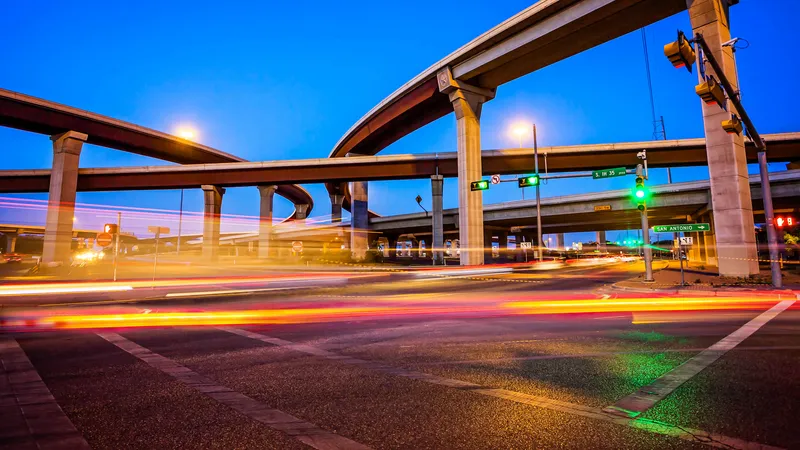Houston TranStar, which has been collecting travel time and segment speed data using vehicle probe data since 1995, has an extensive coverage area that envelops most local commuters' daily freeway routes. However, expanding the existing Automated Vehicle Identification (AVI) system would be cost-prohibitive except for high-volume freeways. The partners of the Houston TranStar consortium needed a new method to measure speeds and travel times on arterial roadway systems and rural freeways. Instead of using co
January 20, 2012
Read time: 4 mins

The partners of the Houston TranStar consortium needed a new method to measure speeds and travel times on arterial roadway systems and rural freeways. Instead of using conventional toll tag readers, licence plate readers or spot speed sensors, the city of Houston, one of TranStar's member agencies, employed the
In their investigation, TTI discovered that Bluetooth-enabled devices in cars accurately and reliably measured segment travel times and speeds.
AVI vs. AWAM
For years TranStar has used the AVI system to collect most freeway travel times and speeds. AVI is a vehicle probe system that reads toll tags to gather data, but can be used on any freeway equipped with sensors.AVI technology, which has only been used on high-volume freeways in the Houston area, is a proprietary system with a high installation cost per monitoring site dependent upon roadway geometry. A typical installation on an eight-lane freeway costs about $100,000.
Because of low equipment costs and ease of installation, Bluetooth readers can cover larger areas than other technologies, making AWAM a more versatile, economic traffic management tool. The detailed cost-benefit analysis below illustrates why this innovative traffic management centre is embracing the new technology.
Seeking answers
In 2008, the city of Houston selected the Texas Transportation Institute (TTI), a research branch of Texas A&M University, to search for reliable and affordable methods of measuring traffic data.TranStar's requirements were that: the new technology cost less than standard AVI; be reliable and standards-based; use non-proprietary equipment and protocols; and have easy, non-intrusive field installation and maintenance with capability for large penetration of field devices and data samples. Data must be owned by the Houston TranStar member agencies.
TTI developed a device using off-the-shelf equipment to read the Media Access Control address (MAC address), the unique identifier of each Bluetooth device. These MAC addresses have no personal information associated with them. TTI called its MAC address-derived reader 'Anonymous Wireless Address Matching' (AWAM).
Side-by-side comparison
TTI partnered with theProject:
Houston TranStar AWAM (Anonymous Wireless Address Matching) for traffic data versus AVI sensors
Cost for four-lane roadway:
$7,000 for AWAM vs. $50,000 / AVI sensor
Savings:
Min. $43,000 per install or 86 per cent of total cost
Benefits:
• Very low-cost, standards-based, non-proprietary equipment and protocols
• Rapid, non-intrusive installation and maintenance
• Capability for large penetration of field devices and data samples
• Real-time data
• Ownership of data by agency/organisationTxDOT then installed the AWAM system at segments along IH 45, a major hurricane evacuation route for the Houston region, from the Woodlands, (north of Houston) to Dallas. Segment travel times are available to Fairfield, Texas (about 125 miles) at %$Linker:
The City of Houston outfitted a network of arterials in west Houston to provide the first real-time traffic data system for an arterial network in the United States. This network will be displayed on the Houston TranStar website in the first quarter of 2011.
Harris County, a third TranStar partner, is integrating AWAM readers into its traffic signal controllers. This will give Harris County real-time travel times and speed data along major arterials. The integration appears promising, although no date is set for the data to be made public.
After only two years, the quantity of Bluetooth-enabled devices on the roads almost equals that of toll tag readers and as smart phones permeate the market, that number continues to grow. Also, because TTI used inexpensive, commercially available materials for its sensors, AWAM can be distributed widely and economically.
Fraction of AVI costs
While maintaining the accuracy and reliability of travel data, AWAM technology is an incredibly affordable, versatile traffic management tool. A single Bluetooth sensor installation at $7,000 ($3,500 for equipment + $3,500 for installation) compares to an installed AVI toll sensor at about $50,000 (four freeway lanes). Able to cover long distances at a fraction of AVI's cost, AWAM technology will save millions of dollars.The sensors also provide a way to manage hurricane evacuations and improve response times to signal failures, incidents and real-time traffic summary calculations.









